
¶ Overview

Banana Pi BPI-CM5 Pro is a computing module powered by the Rockchip RK3576 second-generation 8nm high-performance AIOT platform. It integrates a quad-core Cortex-A72 @ 2.2GHz and a quad-core Cortex-A53 @ 1.8GHz, along with a dedicated NEON co-processor, a 6 TOPS NPU, and supports up to 16GB of large memory. It supports 4K video encoding and decoding, features a rich set of interfaces, and supports various operating systems.
BPI-CM5 Pro adopts Rockchip RK3576 second-generation 8nm high-performance AIOT platform processor, integrating 4 Cortex-A72 and 4 Cortex-A53 and independent NEON co processors; Built in multiple powerful embedded hardware engines, providing excellent performance for high-end applications and supporting 4K@120fps H.265, VP9, AVS2, and AV1 decoders, supporting 4k@60fps H.264 decoder; Also supported 4K@60fps H.264 and H.265 encoders, built-in 3D GPU, fully compatible with OpenGL ES1.1/2.0/3.2, OpenCL 2.0, and Vulkan 1.1.
It is applicable to ARM PC, edge computing, personal mobile Internet devices and other multimedia products.
|
Rockchip RK3576 design Banana Pi BPI-CM5 Pro AI Computer module design Rockchip RK3576 deisgn Banana Pi BPI-M5 Pro AI SBC design Rockchip RK3588 design Banana Pi BPI-M7 AI SBC design |
¶ Key Specifications
-
SOC: Rockchip RK3576
-
CPU: Integrates quad-core Cortex-A72 @ 2.2GHz, quad-core Cortex-A53 @ 1.8GHz, and a dedicated NEON co-processor.
-
GPU: ARM Mali G52 MC3 GPU.
-
NPU: Up to 6 TOPS (INT8) computing power, supporting INT4/INT8/INT16 mixed precision computation.
-
VPU/Video Codec:
-
Decoding: Supports H.264, H.265, VP9, AV1, and AVS2 up to 8K@30fps or 4K@120fps, and high-quality JPEG decoding up to 4K@60fps.
-
Encoding: Supports H.264 and H.265,JPEG up to 4K@60fps.
-
-
RAM: 8/16GB 32bit LPDDR5, default is 8GB, with RK3576 supporting up to 16GB.
-
Flash: 32/64/128GB eMMC, default is 64GB eMMC.
-
Operating Voltage: Wide input voltage range from 4.5V to 23V (voltage tolerance ±5%).
-
Operating Temperature: 0℃ ~ 80℃
-
Weight: 12g
-
Dimensions:
-
CM5 Pro: 55 x 40 mm
-
CM5 Pro IO: 100 x 80 x 29 mm (3.94 x 3.15 x 1.14 inches)
-
¶ BPI-CM5 Pro vs Raspberry Pi CM4
Below is a comparison table between BPI-CM5 Pro and Raspberry Pi CM4
| Specification | BPI-CM5 Pro | Raspberry Pi CM4 |
|---|---|---|
Processor |
RK3576 SoC |
Broadcom BCM2711 |
CPU |
Architecture Quad-core ARM Cortex-A72 & Quad-core Cortex-A53 |
Quad-core ARM Cortex-A72 |
GPU |
ARM Mali G52 MC3 GPU |
VideoCore VI |
Memory |
Up to 16GB |
LPDDR5 1GB, 2GB, 4GB, 8GB LPDDR4 |
Storage |
eMMC storage (optional capacities) |
No built-in storage, supports microSD cards |
Display |
Output 1x HDMI 2.1, 1x DP |
2x HDMI 2.0 |
Video Resolution |
Supports 4K@120fps |
Supports 4K@30fps |
Network Interface |
1x Gigabit Ethernet port |
1x Gigabit Ethernet port |
USB Ports |
1x USB3.0,1x USB2.0 |
1x USB 2.0 |
GPIO |
40-PIN GPIO |
40-PIN GPIO |
Expandability |
2x PCIe/SATA/USB 3.0 |
1x PCIe 2.0 |
Camera Interface |
1x 4-lane MIPI CSI, 1x 2-lane MIPI CSI |
1x 4-lane MIPI CSI, 1x 2-lane MIPI CSI |
Display Interface |
1x 4-lane MIPI DSI |
2x 4-lane MIPI DSI |
Power Input |
5V |
5V |
Dimensions |
55mm x 40mm |
55mm x 40mm |
Operating System |
Debian, Android, Ubuntu, etc. |
Raspberry Pi OS, Ubuntu, others |
Primary Use Cases |
AI development, embedded systems, industrial control, DIY projects, education, IoT |
DIY projects, education, IoT, etc. |
¶ Getting started
¶ Hardware
¶ Hardware Interface
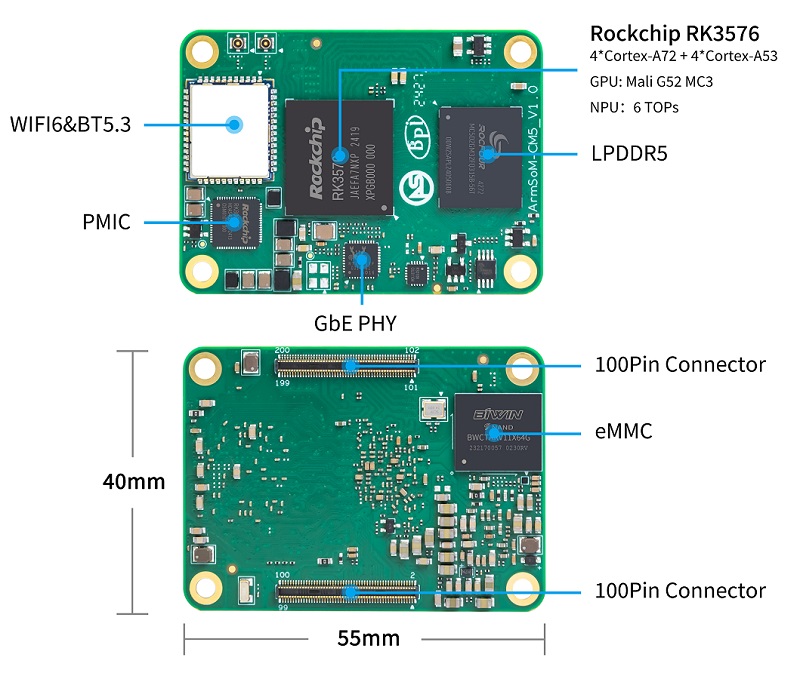
|
1 Designed as a board-to-board connector. 2 Due to the RK3576 chip’s PIN limitations, it supports only 1 HDMI and 1 DSI, whereas the Raspberry Pi CM4 supports up to 2 HDMI and 2 DSI. 3 BPI-CM5 has an additional PCIe and USB3 compared to the Raspberry Pi CM4. |
You can use the Raspberry Pi CM4 baseboard.
¶ BPI-CM5 Pro Photo
¶ BPI-CM5 Pro Block Diagram
BPI-CM5 Pro Block Diagram
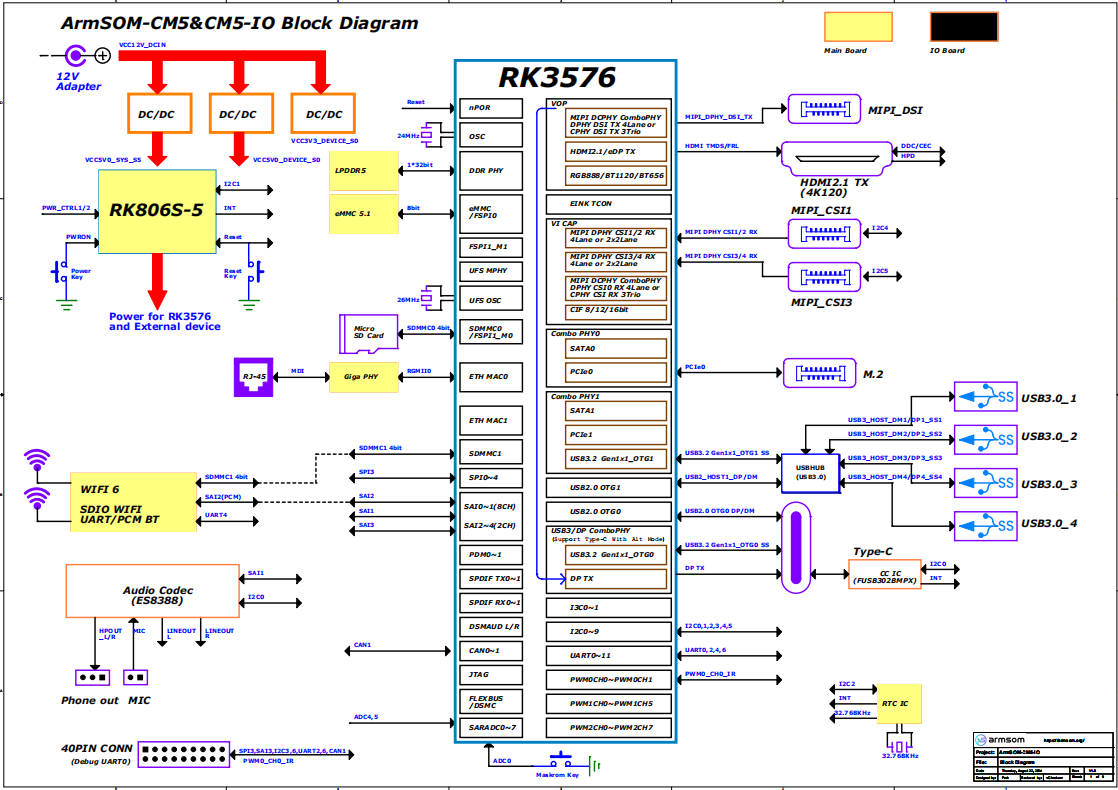
¶ Hardware Spec
| HardWare Specification of Banana Pi BPI-CM5 Pro | |
|---|---|
Item |
Function |
CPU |
RK3576 Quad-core [email protected] and Quad-core [email protected], 8nm process |
GPU |
ARM Mali G52 MC3 GPU |
Fully compatible with OpenGL ES 1.1, 2.0, and 3.2, OpenCL up to 2.0, and Vulkan 1.1. Dedicated 2D hardware engine with MMU maximizes display performance and provides very smooth operation. |
|
NPU |
6 TOPS@INT8 |
Supports INT4, INT8, INT16, FP16, BF16, and TF32 mixed precision |
|
Supports deep learning frameworks: TensorFlow, Caffe, Tflite, Pytorch, Onnx, NNAndroid NN, etc. |
|
VPU/Codec |
Hardware decoding: Supports H.264, H.265, VP9, AV1, and AVS2 up to 8K@30fps or 4K@120fps, and high-quality JPEG decoding up to 4K@60fps. |
Hardware encoding: Supports H.264 and H.265,JPEG up to 4K@60fps. |
|
ISP |
ISP, 16MP |
RAM |
8GB/16GB (up to 16GB) 32-bit LPDDR5, default LPDDR5 8GB |
Flash |
32/64/128GB eMMC, default eMMC 64GB |
Supports MicroSD card expansion |
|
Display |
1x HDMI OUT 2.1, supports 4K@120fps |
1x MIPI DSI resolution up to 2K@60fps |
|
1x DP 1.4 resolution up to 4K@120fps |
|
Camera |
1x 4Lanes MIPI CSI, up to 2.5Gbps per lane |
1x 2Lanes MIPI CSI, up to 2.5Gbps per lane |
|
Network |
1x GMAC, provides RGMII/RMII interface |
Supports 10/100/1000Mbps data transfer rates |
|
PCIe |
2x PCIe 2.0 1-lane |
USB |
1x USB 3.0 |
1x USB 2.0 |
|
Audio |
SPDIF_Tx x1 |
AUDIO_R/L x1 |
|
i2s x1 |
|
¶ BPI-CM5 Pro core board pin definitions
BPI-CM5 Pro core board pin definitions

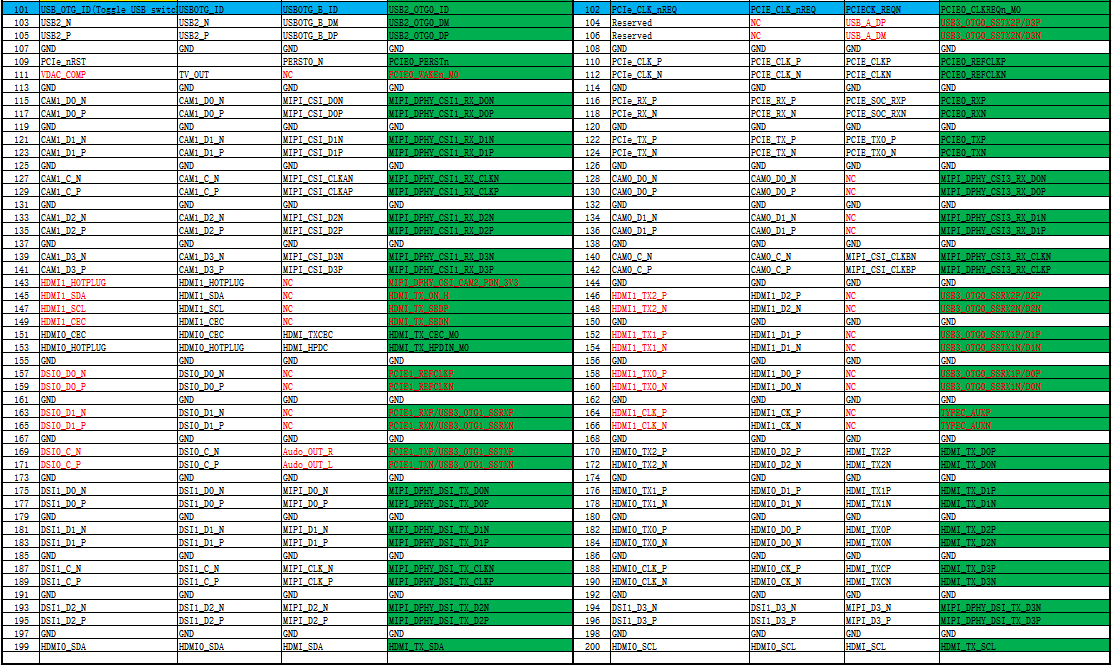
¶ BPI-CM5 Pro IO board
¶ IO board Hardware Specifications
The cm5-io board is an expansion board specifically designed for the CM5 computing module, aimed at assisting in system and embedded board development.
-
1x HDMI output, 1x DP output
-
4x USB 3.0 Type-A
-
Gigabit Ethernet RJ45 with PoE support
-
Firmware flashing and device mode via USB Type-C
-
GPIO: 40-pin header • Power connector: DC Barrel jack for 12V power input
-
Expansion: M.2 (M-key, supports PCIe), microSD
-
MIPI DSI: 1x 4-lane MIPI DSI, supports up to 4K@60fps (x4)
-
MIPI CSI0: 1x 4-lane MIPI CSI, each lane up to 2.5Gbps
-
MIPI CSI1: 1x 2-lane MIPI CSI, each lane up to 2.5Gbps
-
Others: HPOUT, FAN, VRTC
-
Dimensions: 100 x 80 x 29 mm (3.94 x 3.15 x 1.14 inches)
-
Weight: 200g
¶ Hardware Interfaces
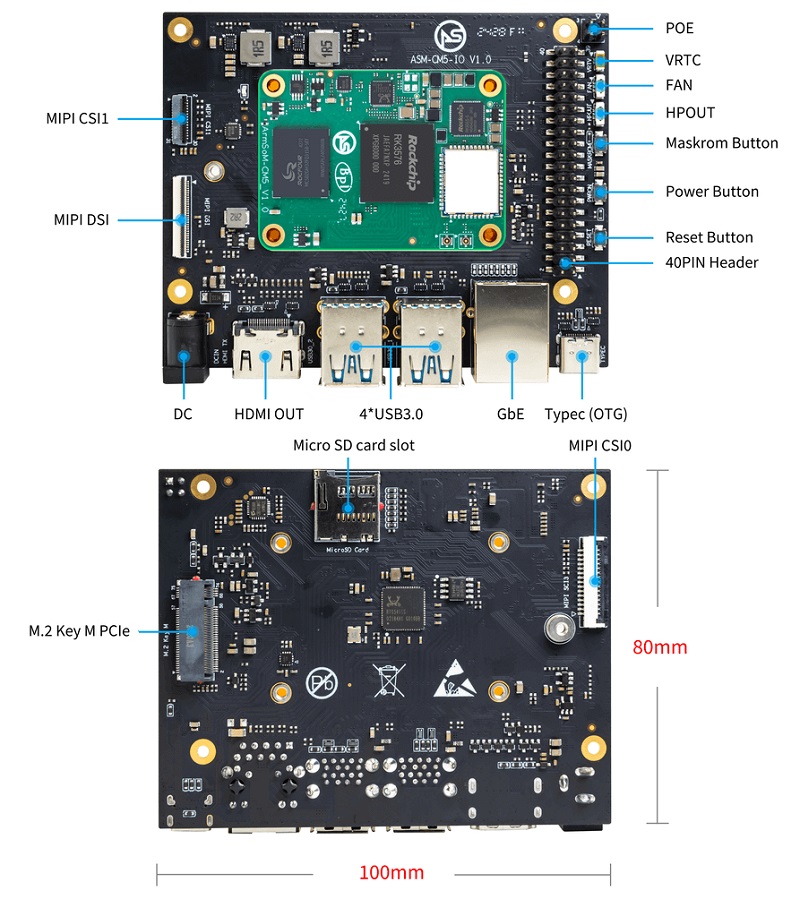
¶ GPIO define
40 PIN GPIO define
| 40 GPIO define of Banana Pi BPI-CM5 Pro | |||||
|---|---|---|---|---|---|
GPIO number |
Function |
Pin |
Pin |
Function |
GPIO number |
+3.3V |
1 |
2 |
+5.0V |
||
140 |
CAN1_RX_M2 / I2C3_SDA_M0 / UART2_RX_M1 / GPIO4_B4_d |
3 |
4 |
+5.0V |
|
141 |
CAN1_TX_M2 / I2C3_SCL_M0 / UART2_TX_M1 / GPIO4_B5_d |
5 |
6 |
GND |
- |
20 |
PWM0_CH0_M0 / GPIO0_C4_d |
7 |
8 |
UART0_TX_M0/ GPIO0_D4_u 28 |
|
- |
GND |
9 |
10 |
UART0_RX_M0/ GPIO0_D5_u 29 |
|
- |
- |
11 |
12 |
- |
- |
- |
- |
13 |
14 |
GND |
|
- |
- |
15 |
16 |
GPIO2_D1_d / UART4_RX_M0 / I2C6_SDA_M2 / PWM2_CH1_M2 |
|
89 |
+3.3V |
17 |
18 |
GPIO2_D0_d / UART4_TX_M0 / I2C6_SCL_M2 / PWM2_CH0_M2 |
88 |
97 |
I2C7_SDA_M1 / SPI3_MOSI_M0 / UART3_RX_M0 / GPIO3_A1_d |
19 |
20 |
GND |
- |
98 |
CAN1_TX_M3 / SPI3_MISO_M0 / SPDIF_RX1_M1 / UART3_CTSN_M0 / SPDIF_RX1_M1/ GPIO3_A2_d |
21 |
22 |
SARADC_VIN4 |
- |
96 |
I2C7_SCL_M1 / SPI3_CLK_M0 / UART3_TX_M0 / GPIO3_A0_d |
23 |
24 |
GPIO3_A3_d / CAN1_RX_M3 / SPI3_CSN0_M0 / UART3_RTSN_M0 / SPDIF_TX1_M1 |
99 |
- |
GND |
25 |
26 |
- |
- |
111 |
I2C4_SDA_M3 / UART2_RX_M2 / GPIO3_B7_d |
27 |
28 |
GPIO2_D6_d / PWM10_M0 / GPIO3_B5_d |
109 |
112 |
I2C4_SCL_M3 / UART2_TX_M2 / GPIO3_C0_d |
29 |
30 |
GND |
- |
126 |
SPI3_MOSI_M1 / PWM2_CH6_M3 / GPIO3_D6_d |
31 |
32 |
- |
- |
- |
- |
33 |
34 |
GND |
- |
- |
- |
35 |
36 |
- |
- |
- |
- |
37 |
38 |
- |
- |
- |
GND |
39 |
40 |
- |
- |
FAN GPIO define
0.8mm connector(CN32)
| Pin | Assignment | Description |
|---|---|---|
1 |
VCC_5V0 |
5V Power ouput |
2 |
GND |
GND |
3 |
PWM |
PWM control |
HPOUT
0.8mm connector(CN3)
| Pin | Assignment | Description |
|---|---|---|
1 |
AOR |
right channel |
2 |
AOL |
left channel |
3 |
GND |
GND |
VRTC
0.8mm connector(J27)
| Pin | Assignment | Description |
|---|---|---|
1 |
+ |
Positive pole |
2 |
- |
Negative pole |
PoE In(J5)
| Pin | Assignment | Description |
|---|---|---|
1 |
VC1 |
TX1 |
2 |
VC2 |
RX1 |
3 |
VC3 |
TX2 |
4 |
VC4 |
RX2 |
¶ With Raspberry Pi CM4 base board
You can use the Raspberry Pi CM4 baseboard.
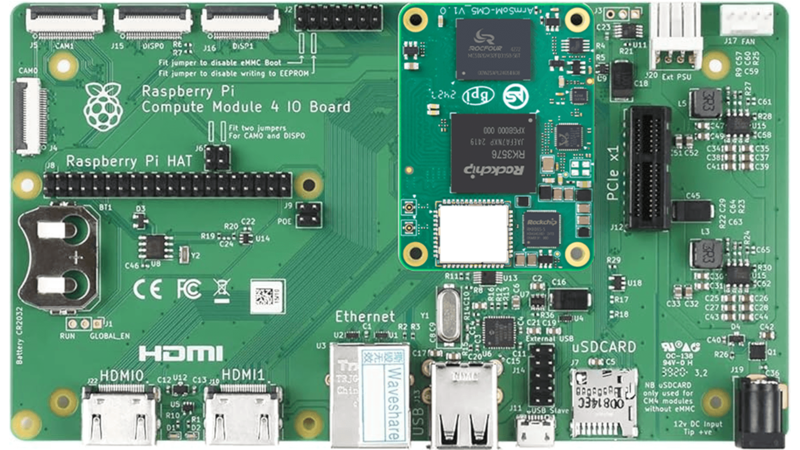
|
1,Designed as a board-to-board connector. 2,Due to the RK3576 chip’s PIN limitations, it supports only 1 HDMI and 1 DSI, whereas the Raspberry Pi CM4 supports up to 2, HDMI and 2 DSI. 3,BPI-CM5 Pro(Armsom CM5) has an additional PCIe and USB3 compared to the Raspberry Pi CM4. |
¶ Development
¶ Source code
-
Armbian : https://github.com/armbian/build
-
BPI-CM5 Pro Kernel : https://github.com/armbian/linux-rockchip
-
BPI-CM5 Pro uboot : https://github.com/rockchip-linux/u-boot
-
BPI-CM5 Pro RKNN-LLM Code repository: https://github.com/ArmSoM/rknn-llm
¶ Resources
-
howto use Raspberry Pi CM4 base board: https://forum.banana-pi.org/t/bpi-cm5-pro-with-rpi-cm4-base-board-fully-compatible-all-interfaces-are-tuned/22012
¶ Hardware Resources
Get schematics, PCB, DXF, and other hardware documentation for the cm5-io development kit to quickly start your development.
-
BPI-CM5 Pro pin table - pin table :
-
BPI-CM5 Pro 2D and SCH :
-
Baidu cloud: https://pan.baidu.com/s/11qhLbFn5pQe3dNqIAZevLw (pincode: 8888)
-
Google drive: https://drive.google.com/file/d/144J06sJoxvJGBPH1Lac2uimxRN9A9PI2/view?usp=sharing
-
-
BPI-CM5 Pro IO SCH 2D and SMD :
-
Baidu cloud: https://pan.baidu.com/s/1goUVjjuy67ldv2sCV4S8DQ (pincode: 8888)
-
Google drive: https://drive.google.com/file/d/18KV7I_JCfbrv0RVi1Z0NjAtebZKjW1BG/view?usp=sharing
-
-
IC and Connector datasheet:
-
Baidu cloud: https://pan.baidu.com/s/13Mma-Pz8I6ndgFytbfMxAQ (pincode: 8888)
-
Google drive: https://drive.google.com/file/d/1oxH9RKtNr5ZnCxBBaDr778t8j17-BWkq/view?usp=sharing
-
¶ Image
¶ Android14
Make your device more personal, protected and accessible with the newest OS upgrade. Improved photo quality, new themes and AI generated wallpapers. Privacy updates for your health, safety and data. And expanded accessibility features.
¶ Debian linux
debian12 for BPI-CM5 Pro: Debian 12 brings thousands of new and updated software packages, supports multiple desktop environments, and processor architectures including 32-bit and 64-bit PC, ARM, MIPS, and PowerPC. However, one of the biggest changes is the upgrade of the Linux kernel from version 5.10 to 6.1 LTS.
Account/Password: armsom/armsom
-
Baidu cloud: https://pan.baidu.com/s/1zPSZQ9DuJGA5vLX2WG_mOw?pwd=8888 (pincode: 8888)
-
Google drive: https://drive.google.com/drive/folders/1hZvr5egTRzWP6sx3IeqD243wXv5gGkW8?usp=sharing
¶ Armbian
Armbian is a computing build framework that allows users to create ready-to-use images with working kernels in variable user space configurations for various single board computers. It provides various pre-build images for some supported boards. These are usually Debian or Ubuntu flavored.
¶ ubuntu-rockchip
This project aims to provide a default Ubuntu experience for Rockchip RK3588 devices. Get started today with an Ubuntu Server or Desktop image for a familiar environment.
¶ Supply Declaration
BPI-CM5 Pro will remain in production until at least August 2034.
¶ Notes
|
[ELECTROSTATIC PROTECTION] 1.Before handling the device, please ensure you wear an anti-static wrist strap or take electrostatic discharge measures to prevent damage to the development board. 2.Assembly should be performed in an electrostatic-safe environment, avoiding operations in dry and low-humidity conditions. 3.When not in use, store the device in an anti-static bag and keep it in a suitably temperature-controlled, low-humidity environment to prevent static electricity buildup. 4.When handling the device, avoid friction or collisions to prevent the generation of static electricity that could cause damage. 5.When holding the device, try to avoid direct contact with the chips on the mainboard to prevent static damage. 6.Do not plug or unplug wires or other devices while the device is operating to avoid damage from electrical surges. 7.When connecting or disconnecting the GPIO/MIPI expansion interfaces, make sure to turn off the power and disconnect the power cable to prevent damage from electrical current. |
|
[HEAT MANAGEMENT] Without effective cooling measures, the surface temperature of the main chip may exceed 60 degrees. When handling the device, please avoid direct contact with the SoC and surrounding power inductors to prevent burns. Ensure that the environment is well-ventilated during operation to prevent localized heat buildup, which could lead to overheating. Additionally, do not place the device in direct sunlight. It is recommended to choose between the official cooling fan, heat sink, or third-party cooling kits based on specific usage conditions to ensure optimal cooling performance. |
¶ Easy to buy
| BANANAPI Official shop: https://www.bpi-shop.com/products/banana-pi-bpi-cm5-pro-computer-module-with-rockchip-rk3576.html |
| BPI Aliexpress shop: https://www.aliexpress.com/item/1005008083579597.html?gatewayAdapt=4itemAdapt |
| SINOVOIP Aliexpress shop: https://www.aliexpress.com/item/1005008083662128.html?gatewayAdapt=4itemAdapt |
| Taobao shop : https://item.taobao.com/item.htm?ft=t&id=849112208375&spm=a21dvs.23580594.0.0.621e2c1bWPo8Iv |
| OEM&ODM Customized product: [email protected] |